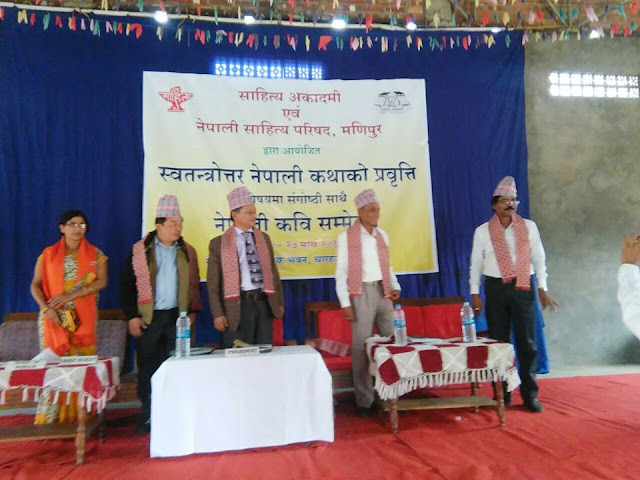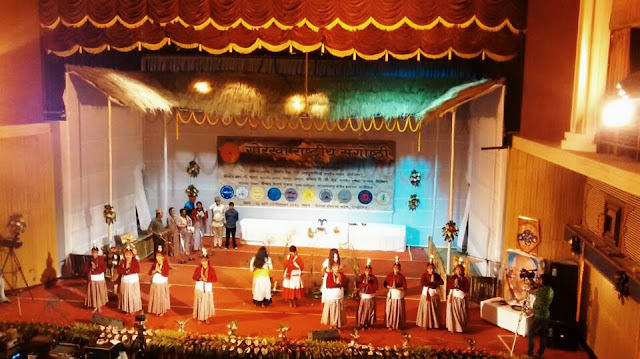The program started at 11:40 A.M with the lighting of the lamps by a few dignitaries such as Col. Alley, Roshan Giri, Jyoti Kumar Rai, Amar Singh Rai and Binay Tamang.
This was followed by a warm welcome of all the other dignitaries, especially those who had travelled from other parts of India with traditional Nepali topi and khada. Mr. Diwakar Gurung was the Master of the Ceremony. The program was marked by numerous traditional and cultural dance performances by the Mangar sangh troupe, Khas Hitkari troup, Kirati Khambu Rai troupe among others.
Some of the main points raised by the guest speakers are as follows:
Ajay Mangar, Mangar Sangh: On behalf of the Janjati Mahasangh, Mr. A. Mangar pointed out that except for a few communities in post independent India, the majority of the Gorkha communities are yet to get the tribal recognition, despite repeated attempts to secure one. The lacunae was in their unilateral approach, which, according to him needs to be rectified through a unity and collaboration among the different non-tribal Gorkha communities.
Binay Tamang: Mr. Tamang briefly spoke about the plight of the Gorkha communities not only in the hills but more importantly all over India and called for “chattis jati, chattis varna” unity amongst the Gorkhas diaspora in India. He specifically said “phutera hoina, jutera afno astitwa ko ladai larnu parcha.” He mentioned that the report on the seminary of Gorkhaland Statehood that had taken place a few months ago will be released tomorrow.
Roshan Giri: Mr. R. Giri pointed out that the demand for tribal status for the ten non-tribal Gorkha communities, excluding the schedule caste was to bring “unity” and eventually “uniformity” amongst the diverse Gorkha communities across India. He was critical of the 6th schedule demand by the GNLF, and called upon the people not to confuse the demand for tribal status with 6th schedule.
Prem Tamang, President of All Assam Gorkha Student Union Assam: Mr. Tamang, acknowledged and thanked Bimal Gurung for “bringing Gorkhas together” and uniting them across India. Pointing out the “identity crisis” that the Gorkhas cross India face and the need for “Gorkha Identity”, he assured the support of more than 35 lac Gorkhas living across Assam – for Gorkhaland as well as for the tribal status of all the non-tribal Gorkhas in India.
Nabin Tamang, President, Nagaland Gorkha Association: Stating that the cause of Gorkhaland as an “emotional issue”, and morally supporting the demand for the tribal status for the non-tribal Gorkhas in India, Mr. N. Tamang, however cautioned the audience and the dignitaries about the unintended repercussions such demand on the Gorkhas living in various parts of India, specially Nagaland. Giving a brief background of the Nagaland, he pointed out the danger of potential conflicts that such status of the Gorkhas across India could entail.
Arun Upadhyaya, President, Assam Gorkha Sammelan (ASG): Mr. A. Upadhyaya spoke of the support of the AGS to GJM under the leadership of Bimal Gurung. He spoke of the various technicalities for the recognition tribal status, and stressed upon the need to undergo Sociological, Anthropological, and Ethnographic (SAE) study.
Buddhi Singh Rana, President, Gorkha Samaj Kalyan Samiti, Roorki, Uttarakhand: Mr. Rana was saddened by the fragmentation within the Gorkha communities, particular by the (state) government, but was happy that the demand for the tribal status has been resurrected, particularly under the leadership of Bimal Gurung. He pointed that that till date we have resorted to the Gandhi an principles but can resort to the ways of Subash Chandra Bose as well.
Sanu Tamang, Secretary General, All Arunachal Gorkha Welfare Society: Mr. S. Tamang gave his full support to the cause of Gorkhaland – “practically, physically and financiall.” He expressed his concern about the looming threat of the Gorkhas being driven out from AP because of the change in status of the Permanent Residence Certificate to Residence Certificate. He forcefully requested the formation of North East Gorkha Federation.
B.R. Joshi, Meghalaya Gorkha Welfare Union: Mr. Joshi briefly spoke about the numerous issues that the Gorkhas in the North East region experience. Talking about the valour and bravery of the Gorkhas during the Indo-Burmese war, he lamented that despite such acts of bravery that the world recognizes, the Gorkhs’s do not have “hamro afnu swaraj(ya).” He further gave his full support to the demand for the tribal status for the non-tribal Gorkhas in India.
Trilok Raj Jaisi, Organising Secretary, GJMM, Mizoram and Mizoram Gorkha Youth Association: Mr. Jaisi gave his support to the Gorkhland Movement as well as the demand for the tribal status for the non-tribal Gorkhas across India. He acknowledged that being from Mizoram, despite being fine socially, the Gorkhas in Mizoram lack political voice. He further called for the Gorkhas to unite.
Vikas Basnet, Executive member Sadar Hills, Automonous District Council, Manipur: Mr. Basnet stated that the Gorkhas in Manpur are “not secure” and are treated as “foreginers” in the absence of Gorkhaland. Because of the lack of political voice, he pointed out that Darjeeling and the Gorkhaland movement here has provided the Gorkhas across India, particularly Manipur the platform – the voice. He also feared the repercussions of anything that happened in Darjeeling but wholeheartedly supported the Gorkhaland movement as well as the demand for tribal status for the non-tribal Gorkhas across India.
N.B. Pradhan, Gorkha representative from Haryana: Mr. Pradhan was cautious of the attempts to divide the Gorkha unity and called upon the current leadership to take the struggle to Delhi. He also called for a “non-violent, non-khukure” and deliberative solution to achieving Gorkhaland.
Rustam Chettri, GJM representative from Delhi: Mr. R. Chetri expressed his severe disappointment for overlooking the unit in Delhi and keeping it in suspension for the past four years. He asserted and recognized the significance of having a functioning units in places like Delhi, where there are numerous cases of discriminations and harassments.
R.P. Waiba, Ceremony Chairperson: Mr. Waiba pointed out that unless we get Gorkhaland, no Gorkha is secure. He summarized the observations of the speakers for a greater unity among the Gorkha communities across India.
Finally, Mr. M.S. Rai, Secretary, Gorkha Janjati Sangarsh Sangoshti Committee: Mr. Rai concluded the program.
One of the common traits that emerged very distinctly among all the guest speakers was the appeal amongst the Gorkha’s all over India to “come together and work in unity” towards the cause of Gorkhaland and the vocal consent, particularly from the dignitaries coming across India in securing the tribal status of the ten non-tribal Gorkha janajati communities in India.

























